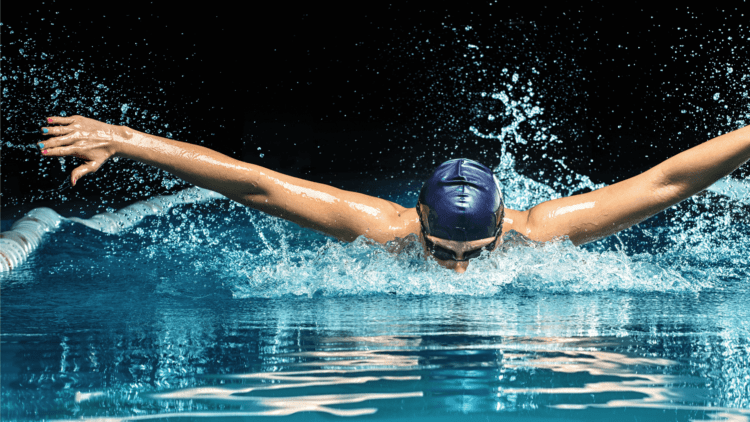
OBJECTIVE OF OLYMPIC SWIMMING: Win the race against other swimmers in the chosen swimming style.
NUMBER OF PLAYERS: 2+ players
MATERIALS: Swimming cap, swimsuit
TYPE OF GAME: Sport
AUDIENCE: 5+
OVERVIEW OF OLYMPIC SWIMMING
Swimming is one of the most popular Olympic sports to watch and compete in. Legends like Mark Spitz and Michael Phelps have really cemented this sport in the lives of the general public. Currently, there are 16 swimming events in the Olympics for both men and women.
SETUP

A swimming race is held in an Olympic-sized pool. This type of swimming pool is approximately 164 feet long, 82 feet wide, and 6 feet deep, with a minimum of 8 lanes.
GAMEPLAY
Starts
There are two starting positions depending on the swimming event.
- On the raised platform above the pool, with swimmers poising themselves at the edge of the platform – freestyle, breaststroke, butterfly, and individual medley.
- In the water, with swimmers facing the wall – backstroke and relay medley.
After the first dive at the start signal, swimmers must re-surface within the first 15 meters (or 49 feet).
Turns
In all swimming events except for the 50-meter race, swimmers must go back and forth along the pool length. There are two ways to execute a turn:
- Somersault into the wall and using feet to launch back off – freestyle and backstroke.
- Touch the wall with both hands at the same time before turning around – breaststroke and butterfly.
After each turn, swimmers must re-surface within the first 15 meters (49 feet).
Strokes

There are four main types of strokes in an Olympic swimming race: freestyle, backstroke, breaststroke, and butterfly.
Freestyle
In a freestyle race, swimmers can use any type of stroke to finish the race. But most swimmers in a freestyle race will use the front crawl technique.
There are also freestyle relay races, in which four swimmers must swim one-fourth of the distance. In a relay, the second swimmer cannot start swimming until the first swimmer touches the wall. And so on.
Backstroke
A backstroke style is similar to a front crawl but with the chest facing towards the ceiling. The swimmers will use flutter kicks to propel themselves forwards, and their arms will alternate.
Breaststroke
In a breaststroke race, swimmers move their arms doing semicircular motions, and the legs do a frog kick. The swimmers’ heads must come above the water at each rotation of these movements.
Butterfly
The butterfly stroke is performed by moving the arms back to front in a semicircular motion. The arm stroke is aided by the dolphin kick, in which the swimmer must simultaneously move their legs up and down.
Medley
The individual and relay medley incorporates the four different strokes in a single race.
In the individual medley, the swimmer must perform each stroke for a quarter of the race, starting with butterfly, backstroke, breaststroke and ending with freestyle.
In the relay medley, the four team members are assigned a particular stroke for the race. The relay starts with the backstroke, then breaststroke, then butterfly, and finally, freestyle.
Distances
There are many different distance events in Olympic swimming, depending on the type of stroke.
Freestyle
- 50 meters
- 100 meters
- 200 meters
- 400 meters
- 800 meters
- 1500 meters
- Relay – 4×100 meters
- Relay – 4×200 meters
Backstroke
- 100 meters
- 200 meters
Breaststroke
- 100 meters
- 200 meters
Butterfly
- 100 meters
- 200 meters
Medley
- 200 meters
- 400 meters
- Relay – 4×100 meters
Disqualifications
There are a few different ways that a swimmer can become disqualified from the race.
- False start: If a swimmer leaves the platform or moves before the starting sound.
- 15-meter rule: A swimmer fails to re-surface at the start of the race or start of a turn in the first 15 meters.
- Touch the wall: If a swimmer fails to touch the wall at a turn. In breaststroke and butterfly, if a swimmer fails to touch the wall with both hands at the same time.
- Relay false start: If a swimmer false starts too soon before their previous teammate touches the wall at the end of their turn.
- Backstroke: If a swimmer flips to their front too soon before a turn or pushes off the wall while on their front.
- Butterfly: If a swimmer performs an illegal kick.
END OF GAME
The first swimmer to get to finish the number of laps needed to complete the distance wins the race. In Olympic swimming, silver and bronze medals are also given to those that come in second and third place, respectively.
- 30 GAMES TO PLAY OVER TEXT - April 22, 2024
- 20+ FREE PRINTABLE BABY SHOWER GAMES - April 16, 2024
- 20+ College Party Games for the Best Night Ever! - April 2, 2024